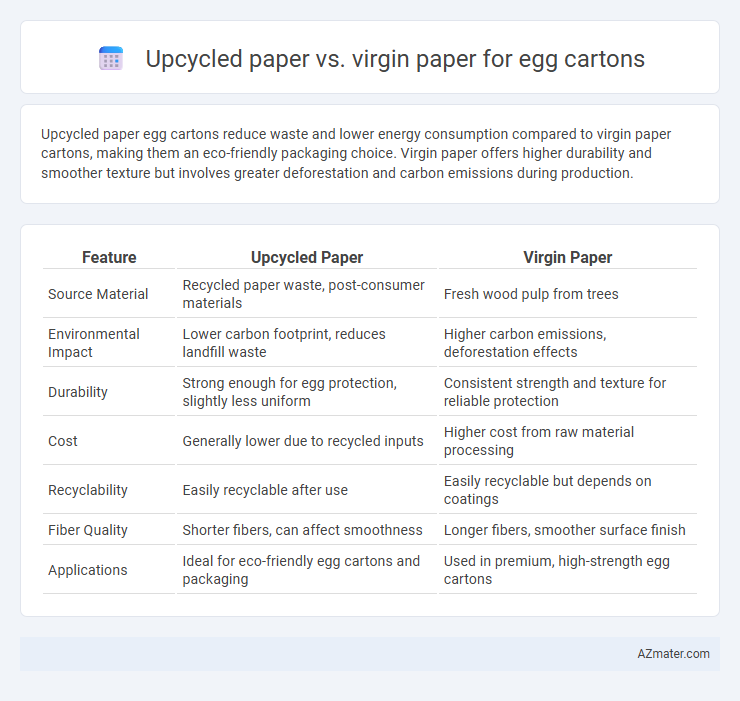Upcycled paper egg cartons reduce waste and lower energy consumption compared to virgin paper cartons, making them an eco-friendly packaging choice. Virgin paper offers higher durability and smoother texture but involves greater deforestation and carbon emissions during production.
Table of Comparison
| Feature | Upcycled Paper | Virgin Paper |
|---|---|---|
| Source Material | Recycled paper waste, post-consumer materials | Fresh wood pulp from trees |
| Environmental Impact | Lower carbon footprint, reduces landfill waste | Higher carbon emissions, deforestation effects |
| Durability | Strong enough for egg protection, slightly less uniform | Consistent strength and texture for reliable protection |
| Cost | Generally lower due to recycled inputs | Higher cost from raw material processing |
| Recyclability | Easily recyclable after use | Easily recyclable but depends on coatings |
| Fiber Quality | Shorter fibers, can affect smoothness | Longer fibers, smoother surface finish |
| Applications | Ideal for eco-friendly egg cartons and packaging | Used in premium, high-strength egg cartons |
Introduction to Egg Carton Materials
Egg cartons are commonly made from either upcycled paper or virgin paper, impacting both environmental footprint and durability. Upcycled paper, sourced from recycled fibers, reduces waste and energy consumption, making it a sustainable choice for protective packaging. Virgin paper, produced from fresh wood pulp, offers higher structural strength but significantly increases deforestation and carbon emissions during manufacturing.
What is Upcycled Paper?
Upcycled paper for egg cartons is made by repurposing waste paper materials, reducing the need for raw resources and lowering environmental impact compared to virgin paper, which is produced directly from wood pulp. This process conserves energy and reduces landfill waste while maintaining the strength and durability required for protective packaging. Upcycled paper contributes to sustainable manufacturing by extending the lifecycle of paper products without sacrificing quality.
Understanding Virgin Paper
Virgin paper used in egg cartons is produced from fresh wood pulp, offering superior strength and uniformity compared to recycled alternatives. It undergoes fewer processing stages, resulting in a cleaner, more durable material ideal for protecting delicate eggs during transport. The higher fiber quality in virgin paper ensures better cushioning and resistance to moisture, critical factors in maintaining egg carton integrity.
Environmental Impact Comparison
Upcycled paper egg cartons significantly reduce environmental impact by utilizing post-consumer waste, lowering landfill contribution and conserving natural resources compared to virgin paper made from fresh wood pulp. Virgin paper production demands high energy consumption and leads to deforestation, whereas upcycled paper minimizes carbon emissions and water usage through recycling processes. Choosing upcycled paper supports sustainability efforts by promoting circular economy principles and reducing overall ecological footprint in egg carton manufacturing.
Resource Consumption: Upcycled vs Virgin Paper
Upcycled paper for egg cartons significantly reduces resource consumption by reusing existing fibers, lowering water and energy use compared to virgin paper production. Virgin paper requires harvesting fresh wood pulp, resulting in higher deforestation rates and increased greenhouse gas emissions. Choosing upcycled paper supports sustainable manufacturing practices through decreased raw material extraction and reduced environmental impact.
Durability and Performance Analysis
Upcycled paper egg cartons exhibit enhanced durability through fiber reinforcement during recycling, offering comparable structural integrity to virgin paper cartons while reducing environmental impact. Virgin paper cartons typically demonstrate consistent performance with uniform fiber quality, providing superior resistance to moisture and compression under heavy loads. Performance analysis reveals that upcycled cartons maintain sufficient durability for standard egg protection but may vary in resilience based on recycled fiber quality and manufacturing processes.
Cost Comparison for Manufacturers
Upcycled paper used in egg carton production significantly reduces raw material costs compared to virgin paper due to its reliance on recycled fibers, which lowers procurement expenses. Virgin paper entails higher energy consumption and raw material costs, driven by the need for fresh pulp and intensive processing, impacting overall manufacturing costs. Manufacturers benefit from upcycled paper by minimizing waste disposal fees and leveraging lower operational costs, making it a cost-effective choice for sustainable packaging.
Consumer Perception and Preferences
Consumers increasingly favor upcycled paper egg cartons due to their environmental benefits and sustainable appeal, associating them with reduced waste and eco-friendliness. Virgin paper cartons, perceived as less sustainable, often evoke concerns about resource depletion and higher carbon footprints. Preference trends show a growing market shift where eco-conscious buyers prioritize upcycled options for packaging, linking product choice to brand responsibility and green values.
Industry Trends in Sustainable Packaging
Upcycled paper egg cartons are gaining traction in the sustainable packaging industry due to their reduced environmental impact and lower carbon footprint compared to virgin paper alternatives. Manufacturers increasingly favor upcycled materials for their ability to divert waste from landfills while maintaining durability and protective qualities critical for egg packaging. Emerging trends emphasize the integration of recycled content and circular economy principles, driving innovation and consumer demand for eco-friendly egg carton solutions.
Conclusion: Choosing the Right Paper for Egg Cartons
Upcycled paper offers a sustainable and eco-friendly option for egg cartons by reducing waste and conserving resources, while virgin paper ensures consistent strength and durability necessary to protect eggs during transport. Balancing environmental impact with performance requirements, selecting upcycled paper is ideal for brands prioritizing green practices, whereas virgin paper suits those needing maximum reliability in packaging. Ultimately, the right choice depends on the specific priorities of sustainability, cost, and product protection within the egg carton supply chain.

Infographic: Upcycled paper vs Virgin paper for Egg carton
 azmater.com
azmater.com